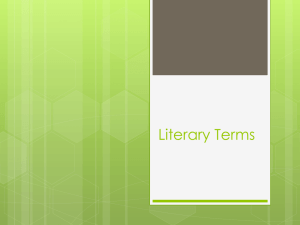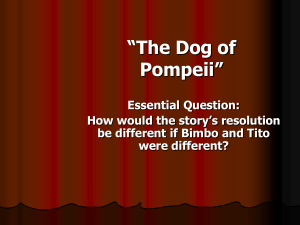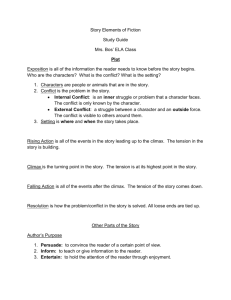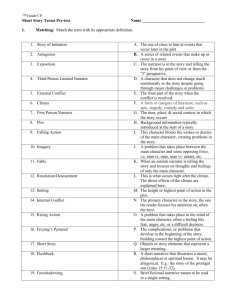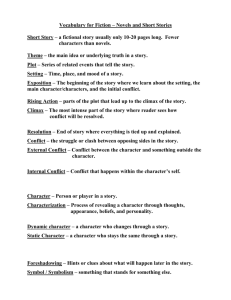Short Story Elements: Plot, Theme, Character & More
advertisement
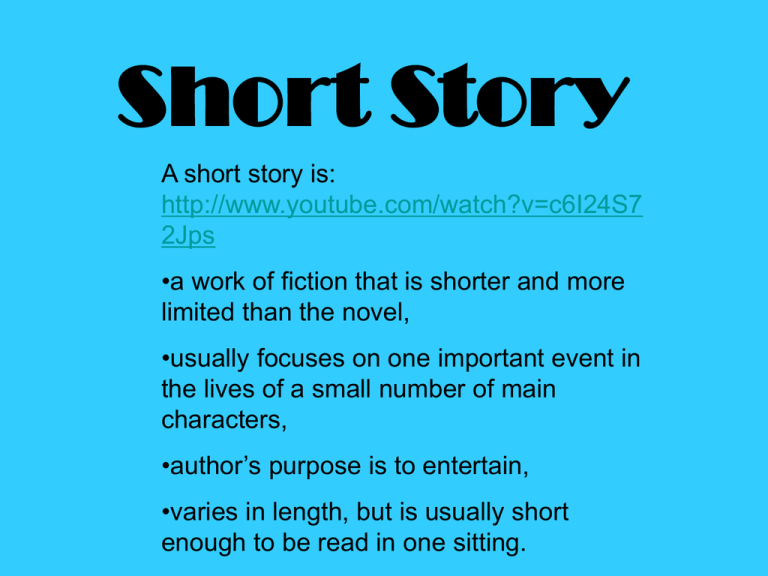
Short Story A short story is: http://www.youtube.com/watch?v=c6I24S7 2Jps •a work of fiction that is shorter and more limited than the novel, •usually focuses on one important event in the lives of a small number of main characters, •author’s purpose is to entertain, •varies in length, but is usually short enough to be read in one sitting. Plot Development Plot Diagram Climax exposition Plot: The sequence of events in a story. resolution Exposition Climax exposition resolution Exposition: the author introduces the characters, creates the setting, and introduces the conflict. Exposition Setting: Setting: Includes where and when the story takes place. How setting is expressed: 1. 2. 3. 4. 5. 6. 7. Place Time of day Weather Seasons Type of People Kinds of clothing Smells, sounds Rising Action & Climax As they say in writing and reading circles . . . the plot thickens!!! Plot Diagram: Rising Action Climax exposition resolution Rising Action: a series of crises, events or turning points that build tension towards the climax. Plot Diagram: Climax exposition Climax resolution Climax: The most intense or crucial moment or event when the tension reaches a peak. The turning point Rising Action: The stairs leading up to the top. There are many stairs that lead there. Climax: You have reached the top of the stairs after a long climb. This is the highest point with the most excitement. It is the turning point that resolves the conflict or problem Falling Action & Resolution Plot Diagram: Falling Action Climax exposition resolution Falling Action: The story examines the consequences or outcomes of the climax and the tension fades. Falling Action: After reaching the climax, the stairs lead back down. There may be many stairs or just a few that lead there. Resolution: The problem or conflict is solved. The last puzzle piece is put into place. Plot Diagram: Resolution Aladdin’s review of Plot exposition Climax resolution Resolution: The story’s main problem or conflict is resolved, bringing the conflict to an end. Theme • Theme is the underlying meaning of the story, a universal truth, a significant statement the story is making about society, human nature, or the human condition. Theme is written as a statement. • Video on Theme Possible Theme Topics: Betrayal Courage Loyalty Fear Freedom Friendship Happiness Honesty Perseverance Theme • What are some of the overall lessons or messages learned in the story? Themes are generally written as statements – Friendship is a wonderful thing. – Perseverance is a worthy character trait. – Trustworthiness is an important quality. – Loyalty can be shown in many ways. – There is no place like home. – Everyone should try to get along. Theme as Disney told it: Definition: A common thread or repeated idea that is incorporated throughout a literary work. Example: “True love conquers all” is the main theme of Sleeping Beauty. Disney / Via lauraestaceysofficialblog.wordpress.com Point of View Perspective from which the story is told. 1st person: In the first person point of view, the narrator is a character in the story. He/She will use pronouns like “I” “we” “. When reading stories in the first person, we need to realize that what the narrator is recounting might not be the objective truth. We should question the trustworthiness of the accounting. 3rd Person : Here the narrator does not participate in the action of the story as one of the characters, but lets us know exactly how the characters feel. We learn about the characters through this outside voice. Types of 3rd person Point of View Omniscient Points of View (3rd person) A narrator who knows everything about all the characters is all knowing or omniscient. Limited Points of View (3rd person) A narrator whose knowledge is limited to one character, either major or minor, has a limited omniscient point of view. As you read a piece of fiction think about these things: •How does the point of view affect your responses to the characters? •How is your response influenced by how much the narrator knows and how objective he or she is? •First person narrators are not always trustworthy. •It is up to you, the reader, to determine what is the truth and what is not. Exposition Character: Character: Person, animal, or imaginary creature that plays a role in the story. Types of Characters: Protagonist: main character in the story, hero(ine). Antagonist: character that causes the initial conflict . . . The bad guy/girl Round: character with many personalities. He/she has many strengths and weaknesses. Flat: this character usually has one kind of personality, such as only good or only evil. Often, less important in the story. Dynamic: this character changes because of what happens to him or her in the story. Often this character learns as a result of an event in the story. Video on static and dynamic Static: This character stays the same throughout the story. Character review video Direct vs. Indirect Characterization Direct Characterization: the writer makes direct statements about a character's personality: • tells what the character is like. Direct Characterization: Ed Johnson scratched his head in confusion as the sales rep explained Dralco’s newest engine performance diagnostic computer. The old mechanic hated modern electronics, preferring the old days when all he needed was a stack of manuals and a good set of tools. Ervin II, Terry . "Fiction Factor - Direct vs. Indirect Characterization." Fiction Factor - Writing Tips for Fiction Writers. N.p., n.d. Web. 6 Oct. 2010. <http://www.fictionfactor.com/guests Indirect Characterization: the writer reveals information about a character and his personality through that character's: • thoughts, words, and actions, • how other characters respond to that character, including what they think and say about him. Indirect Characterization: “That Ed Johnson,” said Anderson, watching the old mechanic scratch his head in confusion as the sales rep explained Dralco’s newest engine performance diagnostic computer. “He hasn’t got a clue about modern electronics. Give him a good set of tools and a stack of yellowing manuals with a carburetor needing repair, and he’d be happy as a hungry frog in a fly-field.” Conflict: Conflict: A struggle or clash between two opposing forces. Conflict: Internal Conflict: External Conflict: Struggle occurs within the character Struggle occurs between the character and an outside force. Person vs. Self Person vs. Person Person vs. Society Person vs. Nature, Person vs. Unknown, Person vs. Technology, Person vs. Supernatural Conflict videos And the plot thickens… • Tone/Mood- the overall emotions or “feel” of the book~ MOOD is within the reader. Tone is the author’s use of words to create feelings within the reader. • Flashback- taking us back to an event that happened before the action of the story. • Foreshadowing- the use of hints to give us more insight into characters’ motives. • Suspense- giving us bits of information along the way that lead us to the climax. Tone/Mood • Tone is the author’s attitude in words in the story • Mood is how the reader feels as he reads • What sort of emotions are you experiencing as you read the book?- mood • How does the author bring out these emotions in the reader?- tone • Are there any words, phrases, sentences, or paragraphs that are particularly strong for this emotion? - tone Flashback • What events from before the action in the book have you learned about? • Why do you think it was important to learn about this event? • How does the author use this information to keep you interested in the story? http://leoashton.vizua.com/blues%20clues/blues_clues_ wp_1024.jpg Foreshadowing • Has the author given you any hints about upcoming events? • Is there a change happening in the weather, the setting, or the mood? • Are there objects or scenic elements that suggest something happy, sad, dangerous, exciting, etc.? • Do characters or the narrator observe something in the background that might be a hint about something to come later? Suspense • What information has the author given you about the conflict in the story? • How has the author used new conflicts to build excitement in the story? • Are you still waiting on information to be revealed? If so, what information are you waiting on? “Charles” and “The Lottery” by Shirley Jackson Shirley Jackson, 1916-1965, one of the most brilliant and influential authors of the twentieth century, is widely acclaimed for her stories and novels of the supernatural, including the well-known short story “The Lottery” and the best-selling novel “The Haunting of Hill House.” Shirley Jackson wrote in two styles. She could describe the delights and turmoil's of ordinary domestic life with detached hilarity; and she could, with cryptic symbolism, write a tenebrous horror story in the Gothic mold in which abnormal behavior seemed perilously ordinary. Excerpt from her obituary published in the New York Times on August 10, 1965 (December, 14, 1916 - August, 9 1965) “Charles” ~Dialogue • Dialogue is the conversation between two or more characters in a novel, short story, drama, etc. • Dialogue is set aside by the use of quotation marks and a short explanation of who spoke the words. There can also be a descriptive word used to describe how the words were spoken. • Every time a speaker changes, a new paragraph should begin, so it won’t always include “said.” How dialogue is used in Charles: • Dialogue is used to show the relating of a story from Laurie to his mother. • His mother becomes increasingly concerned about the environment her son is being taught in. • What do we find out about Charles at the end of the story? Dramatic Irony • Dramatic Irony occurs when the reader knows something that a character does not. “The Lottery” ~Vocabulary Boisterous: noisy and lively; unrestrained or unruly Reprimand: harsh criticism from an authority figure. Interminably: endless or seemingly endless because of monotony or tiresome length Petulantly: easily annoyed, complaining rudely, impatient irritation * * Rising Action- how does the author increase our tension throughout the story? * Point-of-View- why does the author choose to tell the story in third person? * Foreshadowing- how does the author foreshadow the outcome of the story? * Symbolism- how were the symbols of the rocks and the color black used in the story? * Irony- when something is the opposite of what you think it should be. “Harrison Bergeron” by Kurt Vonnegut Writer, novelist. Born on November 11, 1922, in Indianapolis, Indiana. Kurt Vonnegut is considered one of the most influential American novelists of the twentieth century. He blended literature with science fiction and humor, the absurd with pointed social commentary. Vonnegut created his own unique world in each of his novels and filled them with unusual characters, such as the alien race known as the Tralfamadorians in Slaughterhouse-Five (1969). Other novels/stories: The Sirens of Titan (1959), Mother Night (1961), Cat's Cradle (1963), Breakfast of Champions (1973), Jailbird (1979), Deadeye Dick (1982), Palm Sunday: An Autobiographical Collage (1981), and Timequake (1997). November 11, 1922-April 11, 2007 Biography Vocabulary • Vigilance: watchful especially to avoid danger • Luminous: bathed in or exposed to steady light • Doozy: something that is unusually good, bad, big, severe, etc. Story elements to focus on… • Climax- why does the author spend so much time on the climax? • Motive/Conflict- what is it about the main conflict that causes Harrison to behave the way he does? • Theme/Symbolism- how does the symbol of the handicaps help the reader understand theme? • Tone- how does the author’s choice of words cause the reader to feel shocked? “The Bet” by Anton Chekhov One of Russia's greatest writers, Chekhov began his career writing jokes and anecdotes for popular magazines to support himself while he studied to become a doctor. Between 1888 and his death he single-handedly revolutionized both the drama and the short story. Near the end of his life he married an actress, Olga Knipper. He died from tuberculosis in 1904, age 44. Biography taken from: http://chekhov2.tripod.com/ Vocabulary * Rubles: the basic unit of money of Russia * Stake: something that you could win or lose in a game, contest, etc. * Haphazardly: having no plan, order, or direction * Contempt: a feeling that someone or something is not worthy of any respect or approval * Emitted: produced or released * Lackadaisical: careless and lazy * Stealthy: secretly, below the radar * Prominent: noticeable or famous Factual vs. Interpretive Questions • Factual Questions have only ONE correct answer. • Factual questions address only ONE specific part of the story. • Interpretive Questions have MORE THAN ONE possible answer • Interpretive Questions apply to MORE THAN ONE part of the story. Practice Does the lawyer stay for the entire 15 years? Why did the lawyer leave 5 minutes early? Motive • Motive is the reason a character takes a specific course of action. – Not all motives are bad. – Some motives can help lead the character to a resolution. Story elements to focus on… Falling action- how does the author wrap up our questions about the lawyer’s action? Does the author’s explanations satisfy you? Motive/conflict- What was the conflict in the beginning and what was the lawyer’s motive for leaving early? Suspense- what is the question the reader has throughout the story? How is finally answered? “Tell-Tale Heart” By Edgar Allan Poe Poe was born in Boston. He was a poet, writer, editor, and literary critic. His short stories were his main type of writing, and today they are considered some of the best American short stories in history. His tales usually are a mix of mystery and macabre (grim and dealing with death). Poe married his 13-year old cousin, Virginia Clemm. Her early death may have inspired some of his writing. Poe’s best known fiction are Gothic (horror and romance ) in order to appeal to the public’s tastes at the time. born January 19, 1809, Boston, Massachusetts— died October 7, 1849, Baltimore, Maryland Biography Vocabulary Resembled – looked like Distinctly – clearly Cunning – slyly, carefully, cautiously Hideous – very ugly or frightful “I think it was his eye. Yes, it was his eye! One of his eyes was pale blue and dull. It resembled the eye of a vulture.” “The Tell-Tale Heart” is a fun little horror story where the narrator is driven insane because of his obsession with an old man’s creepy eye! The narrator thinks he’s perfectly sane and tries to convince the reader throughout the story. He is suffering from extreme paranoia and mental health issues. Ask yourself: What point of view is the story in? Ask yourself: Whose heart does he really hear beating? Suspense • Suspense is the quality that is created when the reader is uncertain about what will happen next. • In “The Bet” readers are left wondering if the man will stay the whole time or if the banker will win the bet. • In “The Tell-Tale Heart” readers are left wondering if the man will confess his crime. Flashback • Flashback occurs when the author interrupts the action of the story to give us information that occurred before the story began. • At the beginning of “The Tell-Tale Heart” and “The Bet”, both authors tell us that the story they are about to tell has already occurred. “The Tell-Tale Heart” Insanity Plea Use specific evidence from the story to support whether the protagonist is guilty or innocent by reason of insanity. Legal Definition of Insanity In a criminal trial, the word “insanity” means something more specific than when we use it in everyday speech. You can’t say that someone on trial is “insane” just because he did something that most of us would consider “crazy” (like killing someone, chopping up the body, and hiding the pieces under the floorboards.) That’s because, in a trial, when we say someone is insane, we’re saying that the person didn’t fully understand what he or she was doing and therefore shouldn’t be held responsible for his or her actions. Read the following legal definition of insanity: Insanity is a mental illness of such a severe nature that a person cannot distinguish fantasy from reality, cannot manage his/her own affairs, or is subject to uncontrollable impulsive behavior. In criminal cases, a plea of "not guilty by reason of insanity" will require a trial on the issue of the defendant's insanity (or sanity) at the time the crime was committed. In this context, "not guilty" does not mean the person did not commit the criminal act for which he or she is charged. It means that when the person committed the crime, he or she could not tell right from wrong or could not control his or her behavior because of severe mental defect or illness. Such a person, the law holds, should not be held criminally responsible for his or her behavior. (INTERNET SOURCE: www.USLegal.com) • • Example First Piece of Evidence for the PROSECUTION: First of all, the killer remembers everything about the crime and can talk about it calmly. In his confession, the killer says, “Hearken! and observe how healthily, how calmly, I can tell you the whole story” (pg 1). A person who is legally insane cannot distinguish fantasy from reality, so he probably wouldn’t have such an accurate memory of everything that happened. If he remembers all the facts about what he did, this proves that he was aware of reality and was not insane. • • Example First Piece of Evidence for the DEFENSE: First of all, the man was hearing things that weren’t really there. In his confession, the man claimed that he had a very acute sense of hearing. He says, “I heard all things in the heaven and in the earth. I heard many things in hell” (1). It sounds as if this man can’t tell the difference between things he’s actually hearing and things that he’s just imagining—you can’t actually hear sounds coming from heaven or hell. If a person who is legally insane has a hard time distinguishing between fantasy and reality, this man is clearly insane. Figurative Language • Will Ferrell on Figurative Language Comparisons ◦ Analogy- a similarity between like features of two things ◦ Simile- uses like or as to compare 2 things ◦ Metaphor- does not use like or as to compare ◦ Allusion- comparison to a famous person or situation Exaggeration ◦ Hyperbole- highly exaggerated statement ◦ Idiom- an expression whose meaning is not the literal meaning but a figurative one Sounds ◦ Onomatopoeia- the word is the sound ◦ Alliteration- repeating beginning sounds for effect Other ◦ Personification- giving human qualities to inanimate objects ◦ Symbolism- giving special meaning to an object or person Symbolism • Definition: An object, character, figure, or color that is used to represent an abstract idea or concept. Example: Dumbo’s “magic” feather represents courage and self-confidence. Once he truly believes in himself, he no longer needs it as a psychological crutch. Seventh Grade by Gary Soto • How did Gary Soto show the reader how much Victor liked Teresa? Provide text evidence to support your answer. • EXAMPLE OF CITING TEXT EVIDENCE • In “Seventh Grade” by Gary Soto, the protagonist, Victor, likes Teresa. On p. 36, lines 10-11, the narrator refers to Teresa as “a girl he had liked since catechism classes at St. Theresa’s.” On p. 39, lines 73-74, Victor admired how Teresa walked down the hall, “one foot in front of the other.” On p. 42, line 177, the narrator says that “The rosebushes of shame on [Victor’s] face became bouquets of love.” It is clear through Victor’s actions that he likes Teresa and wanted her to be ‘his girl’. • You will use the handout to help you structure a paragraph citing text evidence to support the above thesis.
